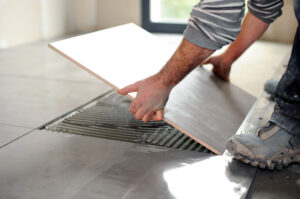There are many considerations to keep in mind when choosing a tile installation. Whether you’re looking to create a new tile floor or re-tile your existing one, you’ll want to consider the type of tile, grout, and other materials you’ll need. You may also want to consider hiring a professional like to help you with the job.

Whether you are laying tile for the first time or you want to upgrade your existing floor, a successful installation requires a subfloor that is level and free from moisture damage. A damaged subfloor can weaken the bond between the tiles and the floor, which can result in cracks, breakage, and a lower resale value.
Subfloors are available in a variety of materials, from oriented strand board (OSB) to concrete. The type you use is dependent on the type of tile you plan to install.
For example, ceramic tiles are more prone to breaking than porcelain or stone tiles. However, they are less expensive and easier to install.
For larger tiles, the subfloor must be level and free from moisture to prevent tile breakage. A waterproof membrane is highly recommended for this step.
Concrete is the most common material for a subfloor, but plywood and sheet metal are also good options. Oriented strand board, plywood, and particleboard are not suited to tiling projects.
Another important part of a successful tile installation is an uncoupling membrane. These membranes create a seal between the tiles and the substrate to prevent movement between the tiles and the subfloor.
An uncoupling membrane is particularly important when installing large tiles on a concrete subfloor. Tiles tend to crack due to the movement of the concrete, which can be prevented by applying an uncoupling membrane.
Another good option for a tile subfloor is a liquid underlayment. This material is designed to be a solid, waterproof surface that will form a smooth surface when dry.
When installing ceramic tile, one of the most important things you need to do is choose the correct backer board. Backer boards provide a smooth surface and help prevent tile from cracking. A backer board is made of cement or fiberglass and can be used on walls, ceilings, or floors.
Cement boards offer the highest level of strength. They are also waterproof and hold up well to moisture. These types of boards are typically used in wet areas.
Glass mat gypsum boards are lightweight and resistant to mold and microorganisms. They are not as stiff as cement boards and are easy to cut.
The backer board should be cut to fit the area. Use a jigsaw with a carbide blade to cut the board. If the area is not a square shape, use grids to mark the location of the board.
Most backer boards require 1/4-inch spacing between the boards. This spacing will not level the floor, but it will create a firm surface.
Before installing the boards, make sure the subfloor is completely level. You can do this by using self-leveling underlayment or other means. Installing the boards over an uneven subfloor will affect the appearance of the finished project.
Before laying the tiles, you will need to apply thin-set mortar. Thinset is a cement-based adhesive that is applied to the backer board. It contains water-retaining agents and polymers.
Wet saws are a great tool for cutting tiles. They have a blade that uses a spraying system to keep the blade cool. This helps ensure that the blade does not wear out, and you get a nice smooth cut.
A wet saw can make the process of cutting tile much faster and easier. However, if you are using one, it is important to know how to use it properly. To do this, you will need to learn a few things.
First, it is important to make sure that you have the proper wet saw. You will also need a water reservoir, an outlet, and a work surface. It is also important to make sure that you have the right blade. Fortunately, many wet saws come in a variety of sizes, so you can find the perfect size for your project.
Once you have everything in place, you should make sure that you have the right safety precautions. In particular, you need to make sure that you have a well-ventilated work area, a good-quality blade, and a properly lit workspace. Also, if possible, you should move your work to an outside location.
Another important factor to consider is the quality of the materials that you are using. For instance, a wet plastic saw will provide less durability than a metal one. Similarly, a cheaper wet saw will not offer the same quality as a more expensive version.
